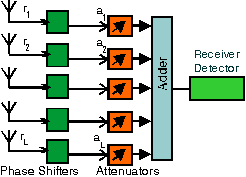
 |
JPL's Wireless Communication Reference WebsiteChapter: Analog and Digital Transmission. |

Figure: L-branch antenna diversity receiver (L = 5)
In the analysis of this correlation, it was assumed that the mobile antenna is mounted at low height and close to all kinds of reflecting and scattering objects. The base station antenna however, is mostly located well above such obstacles. Hence at the base station all multipath waves arrive from approximately the same direction. If the antenna is moved over a certain small distance d, the phase shift is almost identical for all arriving waves. This is in sharp contrast to the situation at the mobile where motion over half a wavelength leads to almost uncorrelated signal phases. To ensure effective antenna diversity at the base station, antennas must be separated much farther than the fraction of the wavelength required for diversity at the mobile.
 Video and
Video and  Slide Show
Slide Show